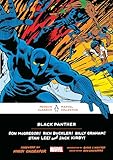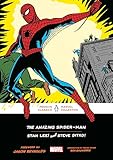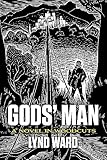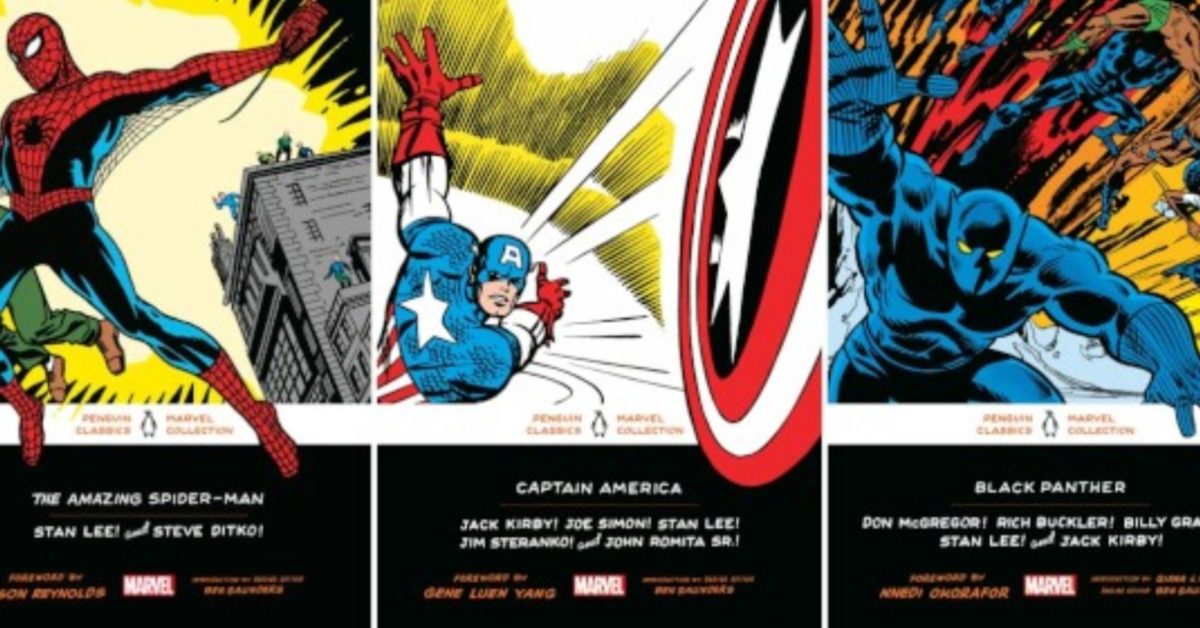
Really, the trouble began in 2013. That was the year Penguin Classics published Morrissey’s Autobiography, a move that caused a ruckus among both fans of Morrissey and Penguin Classics. While some were glad that this onetime icon of the bookish underground was getting his due from the literary establishment, many balked at the decision to include Morrissey—that clever, keening poet of ostracism and martyrdom—in the same catalog as Montaigne and Murasaki.


 Chances are there will be even more handwringing in June of this year, when Penguin Classics will release the first three volumes of their Marvel Collection: Black Panther, Captain America, and The Amazing Spider-Man. Over the past decade or more, the conquest of the cultural landscape by quippy spandexed superheroes has been Napoleonic. The idea that a citadel of bookishness has fallen to this siege of adolescent fantasia could easily take on outsize importance.
Chances are there will be even more handwringing in June of this year, when Penguin Classics will release the first three volumes of their Marvel Collection: Black Panther, Captain America, and The Amazing Spider-Man. Over the past decade or more, the conquest of the cultural landscape by quippy spandexed superheroes has been Napoleonic. The idea that a citadel of bookishness has fallen to this siege of adolescent fantasia could easily take on outsize importance.

 Since its founding in 1946, the Penguin Classics catalog has served as the best and most convenient rendering of the modern canon. Binding an author’s work with that stark and distinctive black cover confers a stamp of approval unlike nearly any other in modern publishing. Penguin Classics began by publishing classics in the most literal sense: the series’ inaugural book was E. V. Rieu’s translation of The Odyssey. Before long, the imprint was pumping out cheap paperbacks of everything from Pascal and Plutarch to Tacitus and Tolstoy. According to Henry Eliot’s The Penguin Classics Book, after the release of sixty titles, editor-in-chief William Emrys Williams asked, “How many more titles in the classical literature of the world are there?” Eliot tut-tuts:
Since its founding in 1946, the Penguin Classics catalog has served as the best and most convenient rendering of the modern canon. Binding an author’s work with that stark and distinctive black cover confers a stamp of approval unlike nearly any other in modern publishing. Penguin Classics began by publishing classics in the most literal sense: the series’ inaugural book was E. V. Rieu’s translation of The Odyssey. Before long, the imprint was pumping out cheap paperbacks of everything from Pascal and Plutarch to Tacitus and Tolstoy. According to Henry Eliot’s The Penguin Classics Book, after the release of sixty titles, editor-in-chief William Emrys Williams asked, “How many more titles in the classical literature of the world are there?” Eliot tut-tuts:
As times have changed, so too has this extraordinary list: the definition of ‘classic’ continues to evolve and expands to embrace new languages, formats and audiences. The titles [in the series] share three key qualities—literary merit, historical significance and an enduring reputation—but within those elastic parameters scholars are adopting new areas of study, translators are broadening their interests and the ‘general reader’ remains hungry for new books, so the list continues to expand.
Even a cursory glance at the line’s expansion in America confirms Elito’s foresight. Every new title—especially those from authors of color, historically excluded from the American literary canon, such as Younghill Kang and Nella Larsen—makes the canon larger and richer. In recent years, Penguin Classics has been marked more by elasticity, expansiveness, and hunger for the new than a desire to fence off high culture from the low. But still—Stan Lee?


 This trio of slam-bang anthologies that comprise the Marvel Collection (it’s the rare spread which does not feature a flying fist or face-bound foot) is a surprising selection for Penguin’s first foray into comics. One might have guessed the imprint would gravitate toward titles given more deference in literary circles: Lynd Ward’s 1929 wordless novel God’s Man, made up of captionless woodblock prints; or Osamu Tezuka’s pioneering postwar manga Dororo, published in 1969; Will Eisner’s 1978 A Contract with God, often credited with popularizing the term “graphic novel.” But by teaming with Marvel, Penguin Classics challenges traditional notions of prestige by elevating a collection of work that is crucial to understanding American popular culture as it transitioned from postwar certainties to a time of greyer ambiguities and unresolved conflicts. Mostly drawn from comics originally published between mid-1960s and mid-1970s run, they serve as a core sample from a fecund period in American comics, when the genre was furiously recalibrating and experimenting.
This trio of slam-bang anthologies that comprise the Marvel Collection (it’s the rare spread which does not feature a flying fist or face-bound foot) is a surprising selection for Penguin’s first foray into comics. One might have guessed the imprint would gravitate toward titles given more deference in literary circles: Lynd Ward’s 1929 wordless novel God’s Man, made up of captionless woodblock prints; or Osamu Tezuka’s pioneering postwar manga Dororo, published in 1969; Will Eisner’s 1978 A Contract with God, often credited with popularizing the term “graphic novel.” But by teaming with Marvel, Penguin Classics challenges traditional notions of prestige by elevating a collection of work that is crucial to understanding American popular culture as it transitioned from postwar certainties to a time of greyer ambiguities and unresolved conflicts. Mostly drawn from comics originally published between mid-1960s and mid-1970s run, they serve as a core sample from a fecund period in American comics, when the genre was furiously recalibrating and experimenting.
Largely devoid of the ironies, ruminations, and absurdities of less mainstream and traditionally “higher-brow” comics, the three entries in the Marvel Collection revolve around combat and struggle. Together, they comprise more than a thousand pages of exceptionally reproduced color panels whose artistry ranges from the merely competent to the spectacular. At many points, Black Panther, Captain America, and Spider-Man are not unlike Odysseus—tested by an array of villains, undone by their own arrogance, tempted by glory, unsure of their fates.
Those conflicts also reflect postwar America’s knotted overconfidence and anxieties: the formless threats of the Cold War, the uncertainties of Vietnam’s quagmire, and the discovery that immense power does not guarantee victory. It can be hard to glean how explicit the political intentions of comic book authors were: like most comics, the issues in the Marvel Collection were produced on tight deadlines by harried creators meeting the whims of a fickle market, at a time when superheroes looked to be a thing of the past.
 From the dawn of the comic book era in the 1930s to the mid-1940s, superheroes were big business. But after the war, the publishing industry moved on. In 1954, psychiatrist Frederic Wertham’s scaremongering book The Seduction of the Innocent painted comics as a pernicious influence on children. The industry responded to the moral panic with a self-censoring Comics Code, which among other things, forbade “sympathy for the criminal” and “scenes of excessive violence” and encouraged promotion of “good grammar.”
From the dawn of the comic book era in the 1930s to the mid-1940s, superheroes were big business. But after the war, the publishing industry moved on. In 1954, psychiatrist Frederic Wertham’s scaremongering book The Seduction of the Innocent painted comics as a pernicious influence on children. The industry responded to the moral panic with a self-censoring Comics Code, which among other things, forbade “sympathy for the criminal” and “scenes of excessive violence” and encouraged promotion of “good grammar.”
In the wake of new restrictions, comic creators tried to bring back some of the two-dimensional World War II-era “super-powered do-gooders” to placate concerned parents, writes Marvel Collection series editor Ben Saunders. These comics did not sell. Against the backdrop of the Korean War, the early civil rights movement, and McCarthyism, “the moral simplicity of the super hero fantasy looked naïve at best and reactionary at worst,” Saunders writes. “Clearly, if super heroes were going to be revived successfully, they would have to be reinvented.”
DC Comics was first to successfully reinvent itself in the Code era, reviving the Flash in 1956. Three years later came the Justice League of America with its superstar roster: Batman, Superman, and Wonder Woman. Martin Goodman, who ran the chaotic constellation of trend-hunting publishing interests that in 1939 became Marvel Comics, tasked hyper-imaginative writer-editor (and his wife’s cousin) Stan Lee with knocking off the Justice League. Lee and artist Jack Kirby met DC’s challenge in 1961 with the Fantastic Four. Two years later, Marvel introduced another super group, the Avengers, made up of Ant-Man, the Hulk, Iron Man, Thor, and the Wasp.
Those two alliances of flawed superheroes relaunched Marvel, changed the genre’s paradigm, and set a template for scrappy group dynamics, still evident in the comic interplay of today’s Marvel Cinematic Universe. Given that, it might seem odd that Marvel didn’t choose one or both of these teams for their first Penguin Classics outing (though more are reportedly in the offing, so they could still be featured).
The single most resilient character in the Marvel catalog remains Spider-Man, who first appeared in August 1962’s Amazing Fantasy #15, the entirety of his origin story laid out in just 11 jam-packed pages, along with the immortal line, “With great power there must also come—great responsibility!” Penguin Classics’s Spider-Man anthology is primarily a run of The Amazing Spider-Man from March 1963 to December 1964. For all the economy and tragedy of Parker’s origin story, the selected issues are remarkably repetitive, but valuable nonetheless. Spider-Man faces such memorable villains as Doctor Octopus and the Green Goblin in this short stretch of time. Parker’s struggle with keeping his identity secret is visually represented by his half-masked face, in a loose rendering of schizophrenia. And unlike nearly every other super hero, he is constantly—refreshingly—worried about money. But these issues’ main conflicts, particularly Peter’s boss’s blinding hatred for Spider-Man, are thin-sketched and monotonous. This may be due to the speed at which the stories were being churned out. In one issue, Peter is misidentified as “Palmer,” not Parker, an error that suggests a breakneck publication schedule.
Spider-Man was generated during a fertile period when Lee and colleagues were pioneering the “Marvel Method.” Most comics are drafted by a writer who hands off descriptions and dialogue for each page to the artist for illustration. The more free-form Marvel Method had the “writer” (Lee) passing ideas to the “artist” (Steve Ditko), who not only drew the panels but made story decisions. In the 1964 The Amazing Spider-Man Annual #1, a three-page feature entitled “How Stan Lee and Steve Ditko Create Spider-Man!” depicts Lee as a giddy self-promoter hurling ideas at a sleep-deprived Ditko, who complains: “I do the drawing while you practice signing your name all over!”
In his chummy and chatty “Bullpen Bulletins,” which appeared in most regular monthly Marvel comic books, Lee created the mythology of Marvel’s stalwart band of brother artists burning the midnight oil to meet deadline. This helped cement Marvel as the smartass alternative to DC’s stolid seriousness, a dynamic that continues today. Unfortunately, none of Lee’s “Bullpen Bulletins” made it into any of the Penguin Classics anthologies.
Amazing Spider-Man was often stitched together by a skein of self-referential, winking, MAD-magazine-style commentary: Cameos from the Fantastic Four or the Avengers, for instance, are treated like sitcom walk-ons. Both tongue-in-cheek and cornball, the schtick pairs well with Ditko’s hammy newspaper strip visuals and works into the action itself. But Captain America and Black Panther have a more serious sense of themselves. The stakes in both were higher. The Penguin Classics Captain America anthology, an incomplete-feeling collection, provides a limited glance at one of Marvel’s most historically salient superheroes. Writer Joe Simon, who created “Cap” with Jack Kirby in late 1940, saw the semi-comical horror of Hitler himself, with “the ridiculous cowlick” and “his swaggering, goose-stepping minions,” as a kind of challenge: “All that was left to do was devise a long underwear hero to stand up to him,” said Simon.
In the first Captain America from March 1941, Steve Rogers has just been christened that long underwear hero when he jumps into action against the Gestapo agent who kills the scientist who created the serum. Within just a couple frames, Captain America is hunting down Nazi saboteurs with the help of Bucky, his gee-willikers pre-teen sidekick (a constant for pre-Code superheroes).
After that, the Penguin Classics anthology jumps awkwardly to just after Cap’s relaunch in 1964, at the height of the so-called Silver Age of Comics, when the industry was reconstituting itself after the Code period. The intervening years had not been kind to the character. Like many veterans, he was adrift after the Axis defeat. Marvel briefly brought him back in the 1950s for some Commie-fighting, but it didn’t take. He returned again in 1964, when the Avengers thawed him out of the block of ice he’d apparently been frozen in since a plane crash in 1945, which killed Bucky. Wracked with survivors’ guilt, Cap was literally a man out of time.
Kirby’s art takes increasingly impressive leaps of detailed kinetic imagination in the issues collected here before handing the reins to Jim Steranko, who wielded a more noirish, cinematic style. But the storytelling is often at a loss for what to do with Cap. After literally recreating many of his World War II adventures—including against Hitler’s cackling henchman Red Skull—Cap is sent up against a gallery of mostly unremarkable hoods. He ends the 1960s in spy flick territory, battling the made-to-order terror group Hydra. Oddly, given that Cap’s origin was focused on fighting Fifth Columnists on American soil, the later revelation that Bucky was not dead but had become the brainwashed assassin Winter Soldier (another enemy within), is omitted from the anthology.
While Cap struggled to find a cause, Black Panther never had to look past Wakanda. In the fantastical African kingdom, thatched huts exist side-by-side with incredible technologies enabled by the metal vibranium. This is all due to T’Challa, Wakanda’s Bruce-Wayne-like king and engineering genius who also took on the mantle of the avenging Wakandan champion Black Panther. (Like Captain America and many other superheroes of the Silver Age, the real-life identities of superheroes were fairly malleable, with multiple laypeople filling their shoes over time.)
Black Panther represents not just a later period of comics from Captain America and The Amazing Spider-Man, but a different approach to storytelling. Though culturally historic as the first Black super hero in a mainstream comic, Black Panther’s introduction in July 1966 (just three months before Huey P. Newton and Bobby Seale founded the Black Panther Party for Self-Defense in Oakland) happened in bog-standard fashion as a guest star in a franchise series. In Fantastic Four #52, the titular foursome journey to Wakanda, where they best a series of challenges set by the Black Panther and, as a result, learn his post-colonial origin story.
The bulk of the Black Panther anthology comprises two story arcs published between 1973 and 1976. Compared to the other two anthologies in the collection, and to Black Panther’s introductory issue, it makes for a head-snapping culture shift. Gone is the wisecracking Marvel voice: Under writer Don McGregor, the prose is still studded with exclamation marks, but more florid and orotund than Lee’s snappy text. The art is layered and dense, bordering on claustrophobic. While the other anthologies draw from Archie and Dick Tracy in spirit and story, Black Panther alludes to African mythology, neo-futurism, Wattstax, and blaxploitation films.
Published in the Jungle Comics series—an unfortunate name nodding to the by-then played-out genre of Tarzan knock-offs—the “Panther’s Rage” arc is a bloody dynastic struggle that hurls T’Challa from one meat grinder to another. Having left Wakanda to help out the Avengers, T’Challa returns to find his kingdom in revolt and threatened by the brutal usurper Killmonger. In issue after issue, T’Challa comes within a whisker of death, his body tossed and bloodied by enemies human and animal (despite the series’ Afro-futuristic spirit, retrograde pulp cliches of Africa live on in its menagerie of killer beasts). The stories’ energy and passion are undeniable, even if the emphasis on incessant combat limits the possibilities for Wakandan world-building. The second arc, “The Panther vs. the Klan,” brings T’Challa to Georgia but despite a climactic scene in which he is tied to a burning cross, never lives up to its potential.
Not that any super hero can ever fulfill their promise. If they did, the fight would be over and the audience would move on. These anthologies show seemingly all-powerful characters continually brought low by bad luck, miscalculation, and a world they cannot control. The space between ideals and reality is where drama lies. That is true not just for these long underwear heroes but many other characters scattered throughout the Penguin Classics catalog, all the way back to Odysseus.
Clearly a commercially astute move by Penguin Classics, the Marvel Collection also serves a purpose in the efforts of the imprint to track the ways that literature has zigged and zagged outside the rarified realm of the bestseller lists. Slamming together hundreds of pages of frustratingly messy stories knocked out month after month by sleep-deprived, underpaid, and feverishly committed artists, these comics were never meant to be read back-to-back. Nevertheless, the anthology’s circuitous battles royale, cheeky humor, and aching vulnerability are what powers the MCU films which have, for better or worse, taken over today’s cineplexes. Based on Eliot’s three-part formulation of what a Penguin Classic needs (“literary merit, historical significance and an enduring reputation”), this series easily meets two of those requirements. As for literary merit, the answer lies with the reader. As it always does.










